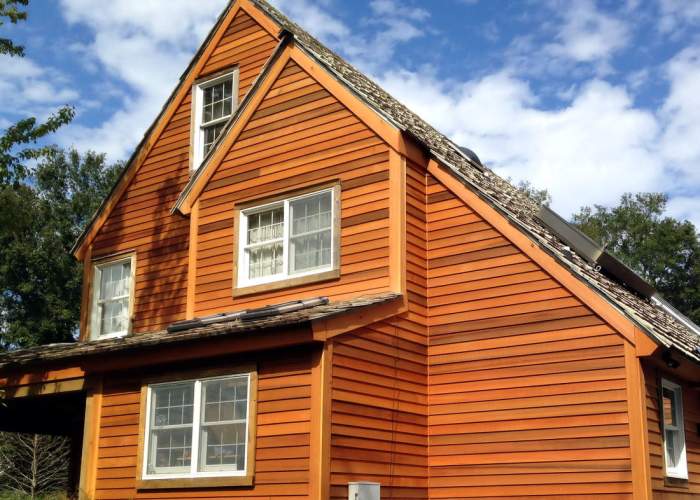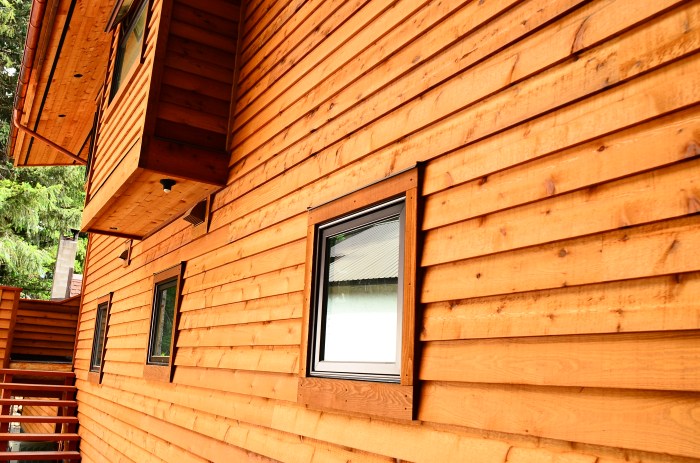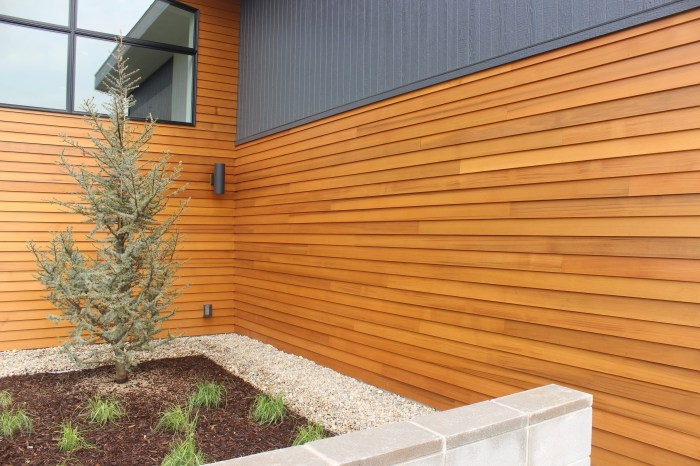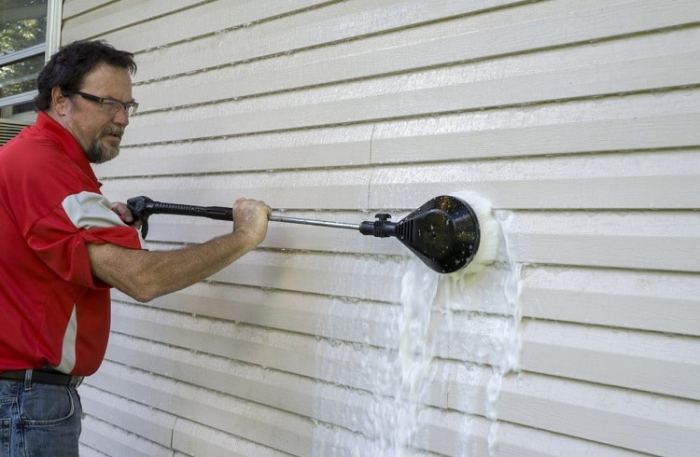NuCedar siding offers a compelling alternative to traditional siding materials, blending the aesthetic appeal of natural cedar with enhanced durability and low-maintenance properties. This guide delves into the composition, installation, environmental impact, cost, and overall value proposition of NuCedar siding, providing homeowners with the information needed to make an informed decision. We’ll explore its unique characteristics, comparing it to vinyl, wood, and fiber cement options, and outlining the advantages and disadvantages to help you determine if NuCedar siding is the right choice for your home improvement project.
Nucedar Siding

NuCedar siding offers a durable and attractive alternative to traditional wood siding, combining the aesthetic appeal of natural cedar with enhanced performance characteristics. This composite material provides homeowners with a low-maintenance, long-lasting exterior cladding solution.
NuCedar Siding Composition
NuCedar siding is a composite material, not a solid wood product. It’s typically composed of a blend of wood fibers, polymers, and other additives designed to enhance its durability, weather resistance, and dimensional stability. The precise formulation may vary slightly depending on the manufacturer and specific product line, but the core components remain consistent. These components work together to create a product that mimics the look and feel of natural cedar without its inherent vulnerabilities to moisture, insects, and decay.
NuCedar Siding Manufacturing Process
The manufacturing process for NuCedar siding involves several key steps. First, wood fibers are harvested and processed. These fibers are then mixed with polymers and other additives, forming a composite mixture. This mixture is then shaped and molded into the desired siding profiles using high-pressure extrusion or similar techniques. After molding, the siding undergoes a curing process to ensure the composite material solidifies and maintains its structural integrity. Finally, the finished siding may undergo a painting or staining process to achieve the desired color and finish. This controlled manufacturing process ensures consistent quality and performance characteristics across different batches of siding.
NuCedar Siding Durability Compared to Other Materials
NuCedar siding offers superior durability compared to traditional wood siding. Unlike wood, NuCedar is resistant to rot, insect infestation, and warping caused by moisture. Compared to vinyl siding, NuCedar generally provides a more natural aesthetic appeal and potentially greater longevity. While fiber cement siding also offers good durability, NuCedar often requires less maintenance and may be easier to install. The precise performance comparison will depend on the specific product and environmental conditions. However, NuCedar typically boasts a better balance of durability, aesthetic appeal, and maintenance requirements than many alternative materials.
NuCedar Siding Maintenance Requirements
NuCedar siding requires minimal maintenance. Regular cleaning with water and a mild detergent is usually sufficient to remove dirt and debris. Occasional power washing may be necessary for more stubborn stains. Unlike wood siding, NuCedar does not require regular staining or sealing. This low-maintenance characteristic contributes to its overall cost-effectiveness over the siding’s lifespan. However, minor repairs, such as replacing damaged panels, may be necessary over time due to unforeseen circumstances, such as severe weather events.
Lifespan and Cost Comparison of Siding Materials
| Siding Material | Estimated Lifespan (Years) | Average Cost per Square Foot | Maintenance |
|---|---|---|---|
| NuCedar | 30-50 | $4-$8 | Low |
| Vinyl | 20-30 | $2-$5 | Low |
| Wood | 15-25 | $3-$7 | High |
| Fiber Cement | 30-50 | $6-$12 | Medium |
Nucedar Siding
NuCedar siding offers a durable and aesthetically pleasing exterior cladding option for homes. Its natural wood fiber composition provides a classic look while benefiting from enhanced resistance to moisture and decay compared to traditional wood siding. This guide details the installation process, design possibilities, and best practices for achieving a professional finish.
NuCedar Siding Installation Steps
Installing NuCedar siding involves several key steps to ensure a long-lasting and attractive result. Proper preparation and attention to detail are crucial for optimal performance. The following steps provide a general guideline; always refer to the manufacturer’s specific instructions for your chosen NuCedar product.
- Surface Preparation: Thoroughly clean the wall surface, removing any loose debris, old siding, or paint. Repair any damaged areas of the sheathing, ensuring a smooth and even base for the new siding.
- Starter Strip Installation: Install a starter strip along the bottom of the wall, providing a level and consistent base for the first row of siding. Ensure the strip is properly aligned and secured.
- Siding Installation: Begin installing the NuCedar siding from the bottom, working your way up. Each piece should overlap the previous one, according to the manufacturer’s specifications. Use appropriate fasteners to secure the siding to the wall, ensuring proper spacing for expansion and contraction.
- Corner and Trim Installation: Install corner and trim pieces as needed, following the manufacturer’s guidelines for proper alignment and overlap. These pieces provide a finished look and protect exposed edges.
- Caulking and Finishing: Apply caulk to seal any gaps or joints between siding pieces and around trim, preventing water penetration. Inspect the finished installation for any imperfections and address them accordingly.
NuCedar Siding Design Examples
NuCedar siding’s versatility allows for a range of design styles. The following examples illustrate how NuCedar can be incorporated into different architectural aesthetics.
NuCedar Siding Colors and Textures
NuCedar siding is available in a variety of colors and textures to complement different architectural styles and personal preferences. The natural wood grain provides a unique texture, while color options range from traditional earth tones to more contemporary shades. For instance, a weathered gray NuCedar siding can create a rustic, aged look, while a rich, deep brown can provide a warm and inviting feel. Smooth finishes offer a clean, modern aesthetic, while textured options can add depth and visual interest.
Surface Preparation Best Practices
Proper surface preparation is critical for successful NuCedar siding installation. This involves thoroughly cleaning the surface to remove any loose debris, dirt, or old paint. Any damaged areas of the underlying sheathing should be repaired to create a smooth and even surface. Moisture content of the substrate should be checked and addressed to prevent future issues. Failure to adequately prepare the surface can lead to problems such as poor adhesion, water penetration, and premature siding failure.
NuCedar Siding Installation Checklist: Tools and Materials
A comprehensive checklist of tools and materials ensures a smooth installation process. Having everything readily available minimizes delays and interruptions.
- Measuring tape
- Level
- Circular saw or hand saw
- Drill with appropriate drill bits
- Safety glasses
- Work gloves
- Caulk gun
- Caulk
- Fasteners (nails or screws)
- NuCedar siding panels
- Starter strip
- Corner and trim pieces (as needed)
Nucedar Siding

NuCedar siding, a popular choice for homeowners seeking a durable and aesthetically pleasing exterior, presents a unique set of environmental considerations. Understanding its lifecycle impact, from manufacturing to disposal, is crucial for informed decision-making. This section delves into the environmental aspects of NuCedar siding, comparing it to other common siding materials and exploring its sustainability profile.
NuCedar Siding Manufacturing’s Environmental Impact
The manufacturing process of NuCedar siding involves several stages that can impact the environment. The harvesting of cedar wood, a renewable resource, can lead to deforestation if not managed sustainably. However, responsible forestry practices, including replanting and selective harvesting, mitigate this impact. The manufacturing process itself consumes energy and water, generating waste products such as sawdust and wood shavings. The application of preservatives and coatings adds another layer of environmental concern, depending on the specific chemicals used. Minimizing waste, employing energy-efficient manufacturing processes, and using environmentally friendly preservatives are crucial for reducing the overall environmental footprint.
Sustainability Comparison of NuCedar Siding with Other Materials
Compared to other siding materials, NuCedar siding offers several sustainability advantages. Unlike vinyl siding, which is derived from petroleum and is not easily biodegradable, NuCedar siding is made from a renewable resource. While wood siding also utilizes a renewable resource, NuCedar siding’s treatment processes can enhance its durability and resistance to decay, reducing the need for frequent replacements and thus minimizing overall resource consumption. Furthermore, the inherent aesthetic qualities of cedar wood often eliminate the need for extensive paint or stain applications, reducing the environmental impact associated with these processes. However, the energy consumption and waste generation during the manufacturing process need to be considered when evaluating its overall sustainability.
NuCedar Siding Recycling Options
Recycling options for NuCedar siding are currently limited. While the wood itself is biodegradable, the presence of preservatives and coatings can complicate the recycling process. In some cases, old NuCedar siding can be repurposed for smaller projects or used as firewood, but widespread recycling programs for this specific material are not yet established. Promoting the development of recycling infrastructure for composite wood products, including NuCedar siding, is crucial for enhancing its overall sustainability profile.
Carbon Footprint of NuCedar Siding Production and Transportation
The carbon footprint of NuCedar siding encompasses emissions from raw material extraction, manufacturing, transportation, and disposal. The distance between the manufacturing facility and the end-user significantly influences the transportation-related emissions. The use of sustainable forestry practices and efficient transportation methods can help reduce the carbon footprint. Furthermore, the longer lifespan of treated NuCedar siding, compared to untreated wood siding, can indirectly contribute to lower carbon emissions by reducing the frequency of replacement. Accurate quantification of the carbon footprint requires a comprehensive life cycle assessment (LCA), considering all stages of the product’s lifecycle.
Environmental Impact Comparison Table
| Lifecycle Stage | NuCedar Siding | Vinyl Siding | Wood Siding |
|---|---|---|---|
| Raw Material Extraction | Moderate (sustainable forestry practices impact) | High (petroleum extraction) | Moderate (sustainable forestry practices impact) |
| Manufacturing | Moderate (energy and water consumption, waste generation) | High (energy-intensive process, emissions) | Moderate (energy consumption, waste generation) |
| Transportation | Low to Moderate (depending on distance) | Low to Moderate (depending on distance) | Low to Moderate (depending on distance) |
| Disposal/Recycling | Low (limited recycling options) | Low (limited recycling options) | Moderate (biodegradability, potential for reuse) |
Nucedar Siding
NuCedar siding offers a compelling blend of aesthetics and durability, making it a popular choice for homeowners seeking a long-lasting and attractive exterior. Understanding the cost implications and long-term value is crucial for informed decision-making. This section will detail the cost of NuCedar siding, compare it to alternatives, and highlight its potential for cost savings.
NuCedar Siding Installation Costs
The total cost of installing NuCedar siding varies significantly depending on several factors. Material costs typically range from $3 to $8 per square foot, depending on the specific profile and finish selected. Labor costs are equally variable and can range from $2 to $5 per square foot, influenced by factors such as project complexity, accessibility, and regional labor rates. Therefore, a homeowner might expect to pay anywhere from $5 to $13 per square foot for a complete NuCedar siding installation, excluding any necessary repairs or additional features. This translates to a total cost ranging from $5,000 to $13,000 for a 1,000 square foot home, with the higher end representing more complex installations or premium finishes.
NuCedar Siding’s Long-Term Value Compared to Alternatives
While the initial cost of NuCedar siding might be higher than some alternatives like vinyl, its longevity and low maintenance requirements contribute to a superior long-term value proposition. Vinyl siding, for example, might have a lower initial cost but may require replacement more frequently due to fading, cracking, or damage from weather. Wood siding, while aesthetically pleasing, demands significantly more maintenance, including regular painting and potential repairs, leading to higher ongoing costs over its lifespan. NuCedar siding’s durability and resistance to rot, insects, and moisture significantly reduce the need for repairs and repainting, making it a more cost-effective choice in the long run. For instance, a homeowner might save thousands of dollars over 20 years by avoiding the repeated painting and repair costs associated with wood siding.
Factors Influencing NuCedar Siding Costs
Several factors significantly influence the overall cost of a NuCedar siding project. These include:
* Siding Profile and Finish: More intricate profiles and premium finishes will naturally command higher prices.
* Project Size and Complexity: Larger homes and projects with intricate details, such as dormers or multiple gables, will increase both material and labor costs.
* Regional Labor Rates: Labor costs vary widely across different regions, with higher rates in areas with a high cost of living.
* Existing Siding Removal: If existing siding needs to be removed before installation, this adds to the overall expense.
* Underlayment and Flashing: Proper installation necessitates the use of underlayment and flashing to prevent water damage; these are additional costs.
Potential Cost Savings with NuCedar Siding
The low-maintenance nature of NuCedar siding translates into substantial cost savings over its lifetime. Unlike wood or vinyl siding, NuCedar rarely requires repainting or extensive repairs. This eliminates the periodic expense of labor and materials associated with these maintenance tasks. For example, avoiding a complete repaint every 5-7 years (a common requirement for wood siding) could save a homeowner several thousand dollars over the siding’s lifespan. This long-term cost savings significantly enhances the overall value proposition of NuCedar siding.
NuCedar Siding Cost Comparison
| Siding Type | Initial Cost ($/sq ft) | Maintenance Cost (per 10 years, $/sq ft) | Lifespan (years) |
|---|---|---|---|
| NuCedar | $5 – $13 | $0.50 – $1.50 | 50+ |
| Vinyl | $2 – $6 | $1 – $3 | 20-30 |
| Wood | $4 – $10 | $2 – $5 | 20-30 |
*Note: These are estimated ranges and can vary based on specific factors Artikeld above.*
Nucedar Siding

NuCedar siding offers a compelling alternative to traditional cedar wood siding, blending the aesthetic appeal of natural wood with enhanced durability and low-maintenance characteristics. This composite material replicates the look and feel of genuine cedar, providing homeowners with a visually attractive and practical exterior cladding option. Understanding the advantages and disadvantages is crucial for making an informed decision.
NuCedar Siding Advantages
NuCedar siding boasts several key advantages over traditional cedar and other siding materials. Its composite nature significantly enhances its resistance to rot, insect infestation, and warping, common problems associated with natural wood siding. This increased durability translates to lower long-term maintenance costs and a longer lifespan for the siding. Furthermore, NuCedar siding often comes pre-finished, eliminating the need for painting or staining and saving both time and money. The consistent color and texture of NuCedar also contribute to a more uniform and aesthetically pleasing finish compared to the natural variations found in real cedar. Finally, the lighter weight of NuCedar can simplify installation, potentially reducing labor costs.
NuCedar Siding Disadvantages
While NuCedar siding offers many benefits, it’s essential to acknowledge its limitations. One potential drawback is the initial cost, which can be higher than that of some other siding materials, although the long-term cost savings associated with reduced maintenance may offset this initial investment. Additionally, the composite nature of NuCedar means it may not offer the same level of customization as natural cedar, potentially limiting design flexibility for some projects. The material’s performance in extreme climates may also vary, and homeowners in regions with harsh weather conditions should carefully consider its suitability. Repairing damaged sections can be more complex than with traditional cedar, requiring replacement of entire panels rather than simple spot repairs.
NuCedar Siding vs. Cedar Wood Siding: A Comparison
NuCedar siding and cedar wood siding both offer attractive aesthetics, but their performance characteristics differ significantly. Cedar wood siding, while aesthetically pleasing, requires regular maintenance, including painting or staining, to protect it from the elements and insect damage. It’s also susceptible to rot and warping over time. NuCedar siding, conversely, requires significantly less maintenance due to its inherent resistance to rot, insects, and warping. While the initial cost of NuCedar may be higher, the reduced maintenance costs over its lifespan can lead to long-term savings. The choice depends on the homeowner’s priorities: the natural beauty and potential for customization of cedar versus the low-maintenance and durability of NuCedar.
Key Pros and Cons of NuCedar Siding
The following list summarizes the key advantages and disadvantages of NuCedar siding:
- Pros: Low maintenance, resistant to rot and insects, consistent color and texture, pre-finished options available, potentially lower long-term costs, lighter weight for easier installation.
- Cons: Higher initial cost compared to some alternatives, potentially less design flexibility than natural cedar, repair may require replacing entire panels, performance in extreme climates may vary.
From its attractive appearance and low-maintenance nature to its sustainable manufacturing process and long-term cost-effectiveness, NuCedar siding presents a strong case for consideration in modern home construction and renovation. By carefully weighing the pros and cons and understanding the installation process, homeowners can confidently incorporate NuCedar siding into their projects, enjoying the beauty and durability it offers for years to come. This comprehensive guide has armed you with the knowledge to make an informed choice, ensuring your siding investment enhances both the aesthetic appeal and long-term value of your property.
Q&A
Is NuCedar siding recyclable?
Recycling options for NuCedar siding vary depending on local waste management programs. Contact your local recycling center for specific information.
How does NuCedar siding withstand extreme weather conditions?
NuCedar siding is engineered to resist moisture, temperature fluctuations, and UV degradation, making it suitable for various climates. Specific performance varies depending on the product line; consult the manufacturer’s specifications for details.
What is the warranty offered on NuCedar siding?
Warranty details vary by manufacturer and product line. Check the manufacturer’s website or contact them directly for specific warranty information.
Can I paint NuCedar siding?
While NuCedar siding is available in various colors, repainting is generally possible. Consult the manufacturer’s recommendations for appropriate paints and application techniques to maintain the warranty.
How does NuCedar siding compare to composite siding in terms of cost?
The cost of NuCedar siding is generally competitive with high-quality composite siding options. The total cost will depend on factors like installation, labor, and the specific product chosen. A detailed cost comparison should be undertaken before committing to either option.



